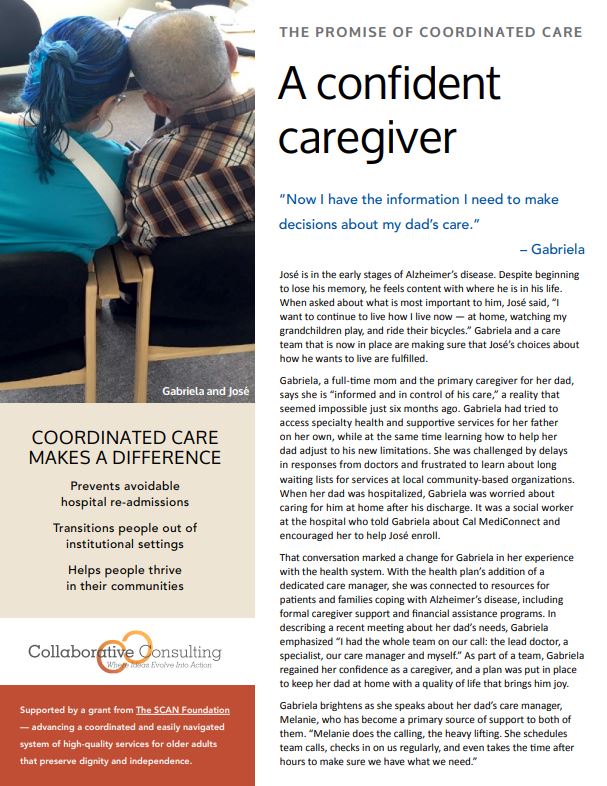The Promise of Coordinated Care: Gabriela’s Story
summary
Coordinated Care Makes a Difference. It prevents avoidable hospital re-admissions, transitions people out of institutional settings and helps people thrive in their communities. Read Gabriela’s case study.
Date Updated: 01/14/2016The Promise of Coordinated Care
A Confident Caregiver
José is in the early stages of Alzheimer’s disease. Despite beginning to lose his memory, he feels content with where he is in his life. When asked about what is most important to him, José said, “I
want to continue to live how I live now — at home, watching my grandchildren play, and ride their bicycles.” Gabriela and a care team that is now in place are making sure that José’s choices about
how he wants to live are fulfilled.
“Now I have the information I need to make decisions about my dad’s care.” – Gabriela
Gabriela, a full-time mom and the primary caregiver for her dad, says she is “informed and in control of his care,” a reality that seemed impossible just six months ago. Gabriela had tried to access specialty health and supportive services for her father on her own, while at the same time learning how to help her dad adjust to his new limitations. She was challenged by delays in responses from doctors and frustrated to learn about long waiting lists for services at local community-based organizations. When her dad was hospitalized, Gabriela was worried about caring for him at home after his discharge. It was a social worker at the hospital who told Gabriela about Cal MediConnect and encouraged her to help José enroll.
That conversation marked a change for Gabriela in her experience with the health system. With the health plan’s addition of a dedicated care manager, she was connected to resources for
patients and families coping with Alzheimer’s disease, including formal caregiver support and financial assistance programs. In describing a recent meeting about her dad’s needs, Gabriela
emphasized “I had the whole team on our call: the lead doctor, a specialist, our care manager and myself.” As part of a team, Gabriela regained her confidence as a caregiver, and a plan was put in place to keep her dad at home with a quality of life that brings him joy.
Gabriela brightens as she speaks about her dad’s care manager, Melanie, who has become a primary source of support to both of them. “Melanie does the calling, the heavy lifting. She schedules
team calls, checks in on us regularly, and even takes the time after hours to make sure we have what we need.”
Download the publication for all visuals and complete references.
Continue Reading
This is the third report coming from the California Medicaid Research Institute (CAMRI) project entitled: Comprehensive Analysis of Home- and Community-Based Services in California. The report describes Medicare and Medi-Cal spending for those beneficiaries using long-term services and supports funded by Medi-Cal.
The California Medicaid Research Institute (CAMRI) developed an integrated and longitudinal database containing Medi-Cal and Medicare claims and assessment data of LTSS recipients in California in 2008. CAMRI’s integrated database provides a unique opportunity to look at characteristics and program spending across the entire care continuum for beneficiaries with LTSS needs within Medi-Cal and for dual eligibles across Medicare and Medi-Cal. This report focuses on LTSS use and spending in the eight duals demonstration counties.
On March 27, 2013, the State of California and the Centers for Medicare and Medicaid Services (CMS) formalized a Memorandum of Understanding (MOU) to establish a Federal-State partnership to implement the Dual Eligibles Integration Demonstration, also referred to as Cal MediConnect. This Fact Sheet provides background information about Cal MediConnect and summarizes the key points of the MOU.


